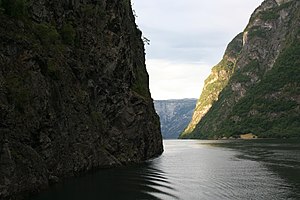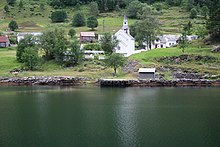Nærøyfjord
| Nærøyfjord | ||
|---|---|---|
|
View over the fjord to Bakka |
||
| Waters | Sognefjord | |
| Land mass | Scandinavian peninsula | |
| Geographical location | 60 ° 56 '37 " N , 6 ° 55' 53" E | |
|
|
||
|
Nærøyfjord |
||
The Nærøyfjord is a fjord in Norway in the municipality of Aurland . It is a tributary of the Sognefjord and is 17 kilometers long. The fjord is popular for its spectacular scenery. In the summer months, larger tourist ships also sail through the narrow fjord to Gudvangen at the end of the fjord. Together with the Geirangerfjord , the Nærøyfjord was added to the UNESCO World Heritage List on July 14, 2005 .
Geography, landscape and geology
Around 2.5 million years ago, rivers carved out deep valleys along geological weak points. The fjords of this area were formed when the glaciers of the Quaternary Era formed these valleys into large trough valleys with exceptionally high and steep rock walls in which seawater collected after the end of the Ice Age.
The fjord is characterized by the steep rock walls up to 1760 meters high, which frame the fjord on both sides. At its narrowest point, the fjord is only 250 meters wide. Due to the risk of falling rocks, large ships are not allowed to use the horn while passing through the narrowest point.
Flora and fauna
Characteristic of the fjord are its varying types of landscape, from the high mountains at Fresvikbreen over high alpine pastures to the deciduous forest overgrown, sheltered bays. The biodiversity of the flora results from the many different habitats and the exceptionally mild climate. The formerly cultivated pieces of land offer another special habitat for some plants. One of the rarest plants in the fjord area is the arctic poppy .
Not least because of the diversity of plants, numerous mammals live in and around the Nærøyfjord such as mountain animals , elk , deer , roe deer , arctic foxes , lynxes , otters , lemmings and porpoises, but also fish , insects and over 100 species of birds , including the white-backed woodpecker and many other sea , Waders , forest and high mountain birds . Quite a few animals are on the red list of endangered species .
Cultural history
When the glaciers in this area melted around 10,000 years ago, the first settlers arrived. The great importance of reindeer hunting at that time could be demonstrated by means of animal graves and hunting hiding places .
On both sides of the fjord there are a few small settlements and farms such as Styvi and Dyrdal, which can only be reached by water. On the west bank is Bakka with the church built in 1859. Bakka can be reached via a road and a tunnel from Gudvangen.
UNESCO World Natural Heritage
Together with the Geirangerfjord , the Nærøyfjord was declared a UNESCO World Heritage Site "Western Norwegian Fjords" (Norwegian Vestnorsk fjordlandskap ). This is due to the fulfillment of two nature conservation criteria, as the area has a unique natural diversity, which was created by the symbiosis of sea and high mountains, and a landscape that is largely unaffected by human interference.
The 1227 km² area (of which 107 km² water area) includes the inner areas of the fjords, which extend to the central mountain range, which geographically separates eastern Norway from western Norway. The area around the Geirangerfjord has a size of 518 km², that of the Nærøyfjord an area of 709 km².
The UNESCO Committee justified the decision to include the fjords as follows:
“The Western Norwegian fjords represent classic and, above all, particularly well-developed types of fjords, which can be seen as typical examples for all fjords in the world. Their power and majesty are comparable to other fjords that have already been included in the World Heritage List. Furthermore, they are characterized by their special climatic and geological conditions. The area exhibits all of the elements of the processes that form two of the longest and deepest fjords in the world.
Nærøy- and Geirangerfjord are considered to be by far the most beautiful fjord landscapes in the world. Their sublime nature is expressed by the narrow, steeply sloping valley walls, which extend from 500 m below sea level to 1,400 m above sea level. Numerous waterfalls plunge down the extremely steep rock faces, and countless torrents flow from snow-capped peaks, glaciers and glacial lakes through deciduous and coniferous forests down into the fjord. The variety of other natural phenomena on land and water, such as submarine moraines and marine mammals, enhance the experience of nature. Remains of old, now abandoned farms and alpine huts give the dramatic natural landscape a cultural dimension that support and reinforce the value of this area. "




